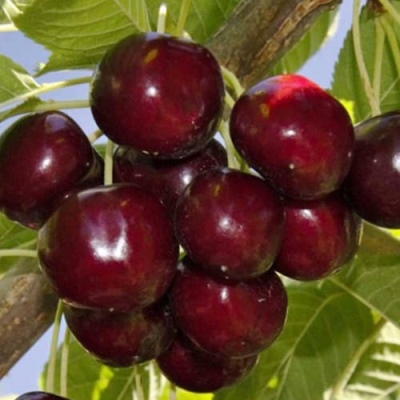
- Fruit shape: rounded, flattened towards the top
- Keeping quality: good
- Authors: Summerland Research Station, Canada
- Appeared when crossing: Van x Stella
- Growth type: vigorous
- Appointment: for all types of processing, for fresh consumption
- Yield: high
- Crown: slightly branched, spherical
- Fruit size: large
- Fruit weight, g: 9,5-11
Gardeners owe the appearance of a number of highly productive and large-fruited varieties of sweet cherry to the Canadian breeding program. One of the best achievements of Canadian scientists is the Lapins variety.
Breeding history
Lapins was bred at an experimental station in Summerland, British Columbia, Canada. The Scientific Experimental Station, founded in 1914, is now part of the Pacific Agri-Food Research Center. This scientific institution plays an important role in the world selection of sweet cherries: about 80% of all modern varieties of this stone fruit crop have been developed here.
The variety was bred in 1971 by Charles Lapins, holder of a doctorate and an honorary medal from the American Pomological Society for his outstanding contribution to breeding science. Sweet cherry Lapins is the result of crossing Van and Stella varieties. The crop was approved for cultivation in 1983. Most of the cherry varieties created in Summerland were named with the letter "C", but this variety was named after its creator in honor of his merits. The variety has long held a leading position in the commercial market in Canada and the United States.
Description of the variety
Lapins is a self-fertile fruitful variety of large-fruited sweet cherry for universal use. Forms a vigorous tree (2.5-4 m) with a spherical, weakly branched crown and branches directed upwards. The leaves are large, dark green towards the end of summer, densely cover the tree and almost completely hide the harvest.
Fruit characteristics
The very beautiful Lapins fruits measuring 28-30 mm and weighing 9.5-11 g are colored at first in a yellow-orange hue. Gradually, it turns red and turns into a rich dark red at the stage of ripeness. The orange subtone is retained. Shiny cherries are round, with a slightly flattened top. The stalk is firmly attached to the branch and holds the fruit, so the crop does not crumble.
The red pulp is aromatic, juicy, dense, slightly crunchy. Medium-sized stone can be easily separated. The juice is light red.
Fruits are resistant to cracking. They have a dry separation, an excellent presentation and are well tolerated during transportation.
Taste qualities
Tasters highly appreciate the taste of the variety, giving it an almost maximum score (4.8 out of 5). The taste has a balance of sweetness and sourness. Sweet cherries are consumed fresh, used for baking. The fruits can be frozen, cooked from them delicious jam, jelly, compote, make cherry wine or liqueur.
Ripening and fruiting
Sweet cherry Lapins can give a signal harvest already for 2-3 years of life. A full bountiful harvest is obtained from a 4-year-old tree. The variety bears fruit in the mid-late period: from about 20 to 30 June, although the ripening process can stretch until mid-July.

Yield
Lapins has a stable yield of 25-30 kg of berries from a tree. Adult cherries can show record productivity and bring up to 50 kg.The fruits ripen almost at the same time, the crop can remain on the tree for a long time, without overripe and without crumbling.
Growing regions
Lapins was extremely popular in his homeland in the late 90s and is now returning to its former glory. Lapins is well known in Europe, especially in Germany. It is planted en masse in Belarus and Ukraine. It is also widespread in the southern regions of Russia. The frost resistance of the variety is weak.
Self-fertility and the need for pollinators
Lapins is a self-fertile variety that does not need the proximity of other varieties and artificial pollination. At the same time, this cherry itself can act as a pollinator for self-fertile trees. Early and intense flowering. Spring frosts are dangerous for future ovaries.
Growing and care
Lapins can be grafted onto low-growing rootstocks (VSL2). A healthy seedling is planted in the spring in a sunny, draft-free place in loose soil with good drainage. One of the most common tree planting schemes is 4x2 m, because it grows compact, and the shoots have vertical growth.
The crown must be formed for sanitary purposes and to increase yields. Top dressing is applied at planting, they will last for 3 years, then the necessary fertilizers are used seasonally.




Disease and pest resistance
Lapins is susceptible to insect attacks, preventive spraying is required.
The variety is susceptible to moniliosis, so you need to completely remove the affected shoots and use fungicides. In the characteristics of the variety, good immunity to clasterosporia and coccomycosis is declared, but gardeners claim that the causative agent of coccomycosis still quite often infects the plant.

































































